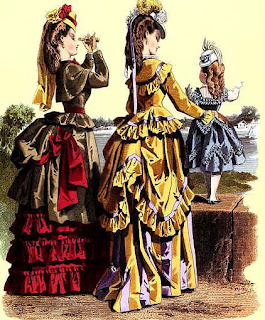Fashion
The
mid-nineteenth century lady was a vision of elegance and grace, women wanted to
look like fragile ladies and wanted a beauty like a flower. New machinery and
materials changed clothing in many ways. Like the new clothing matertials from british colonies came
and new tequnic in dying the clothes med the clothes brighter. Clothes was made in different colors, from pastels to
darker colors. Different
shades of green were very popular
Women's
fashions changed enormously and rapidly through the 1800s. A typicall Victorian dress was trimmed with
frills, flounces, lace, braid, fringe, ruche and ribbons. Petticoats, corsets, chemises were worn under
gowns. By the 1850s the number of petticoats was reduced and the crinoline was
worn. The Bell-shaped skirts became wider and wider.
Woman putting on a crinoline. Looks very cumfy. I can imagine how it must be going to the toilet.
Day dresses had a solid bodice and evening gowns had a very low neckline and
were worn off the shoulder with shawls. The neckline was worn in a high
V-neck. The dress was worn in two pieces and connected with hooks and ties. The sleeves
changed many times throughout the era. They used boots/ shoes with heels
and pointed or squared toes.
Accessories
they were was :
-
Shawls,
cloaks, mantles, scarves and little aprons.
-
Gloves and parasols.
-
Large
brooches were worn at the throat
-
large and small earrings.
-
fans , Boas made of feathers or fur.
-
But
the most popular accessorie was the hat:
-
Hats
were primarily used as a protection from the sun, they wanted to be pale... In
the late years, hats became a symbol of style statement and authority.
Found a bit funny video on youtube about the how the Ideal victorian woman should act and dress.
I dont think I would be to happy living in that time. It seems like they did not have a lot of indenpence and their lifes went from living at home with their parents and straight to living with your husband and then lving for your children. Constantly pleasing others.
Family life
By the Victorian era, the concept of "pater familias", meaning the husband as head
of the household and moral leader of his family, was firmly entrenched in
British culture. A wife's proper role was to love, honour and obey her husband,
as her marriage vows stated. A wife's place in the family hierarchy was
secondary to her husband, but far from being considered unimportant, a wife's
duties to tend to her husband and properly raise her children were considered
crucial cornerstones of social stability by the Victorians. Women seen as
falling short of society's expectations were believed to be deserving of harsh
criticism.
Sexuality
The ideal Victorian woman was pure, chaste, refined, and modest. This
ideal was supported by etiquette and manners.
Women were expected to have sex with only one man, their husband.
However, it was acceptable for men to have multiple partners in their life. If
women did have sexual contact with another man, they were seen as ruined
or fallen.
I find these picture very sad. It really hit
me. The Outcast by Richard Redgrave, 1851. A patriarch kicking
his daughter and her illegitimate baby out of the house. . Victorian women had few legal
rights to protect them, including child support or secure employment.
Frederic Watts, c.1850, depicts a woman's body washed up beneath the
arch of Waterloo Bridge, drowned after throwing herself in the river to escape
the shame of being a "fallen woman"
Education
Women were not freely offered the
opportunity to study subjects of an extended, classical, and commercial nature.
This made it difficult for a woman to break free from the societal constraints
to achieve independent economical status. Education was specialised by gender.
They could study history, geography and general literature which would give
them interesting but noncontroversial topics for discussion. The male subjects
was law, physics, engineering, science and art. It was said studying this was
against their nature and they could get ill from it.





Ingen kommentarer:
Legg inn en kommentar